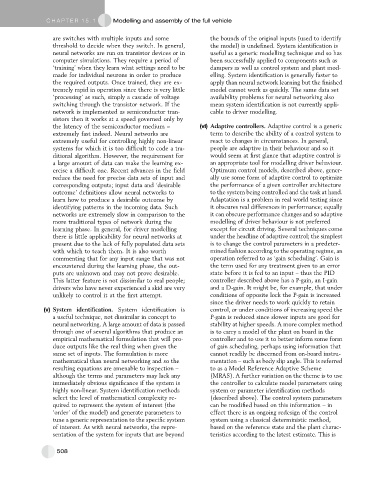Page 500 - Automotive Engineering Powertrain Chassis System and Vehicle Body
P. 500
CHAP TER 1 5. 1 Modelling and assembly of the full vehicle
are switches with multiple inputs and some the bounds of the original inputs (used to identify
threshold to decide when they switch. In general, the model) is undefined. System identification is
neural networks are run on transistor devices or in useful as a generic modelling technique and so has
computer simulations. They require a period of been successfully applied to components such as
‘training’ when they learn what settings need to be dampers as well as control system and plant mod-
made for individual neurons in order to produce elling. System identification is generally faster to
the required outputs. Once trained, they are ex- apply than neural network learning but the finished
tremely rapid in operation since there is very little model cannot work as quickly. The same data set
‘processing’ as such, simply a cascade of voltage availability problems for neural networking also
switching through the transistor network. If the mean system identification is not currently appli-
network is implemented as semiconductor tran- cable to driver modelling.
sistors then it works at a speed governed only by
the latency of the semiconductor medium – (vi) Adaptive controllers. Adaptive control is a generic
extremely fast indeed. Neural networks are term to describe the ability of a control system to
extremely useful for controlling highly non-linear react to changes in circumstances. In general,
systems for which it is too difficult to code a tra- people are adaptive in their behaviour and so it
ditional algorithm. However, the requirement for would seem at first glance that adaptive control is
a large amount of data can make the learning ex- an appropriate tool for modelling driver behaviour.
ercise a difficult one. Recent advances in the field Optimum control models, described above, gener-
reduce the need for precise data sets of input and ally use some form of adaptive control to optimize
corresponding outputs; input data and ‘desirable the performance of a given controller architecture
outcome’ definitions allow neural networks to to the system being controlled and the task at hand.
learn how to produce a desirable outcome by Adaptation is a problem in real world testing since
identifying patterns in the incoming data. Such it obscures real differences in performance; equally
networks are extremely slow in comparison to the it can obscure performance changes and so adaptive
more traditional types of network during the modelling of driver behaviour is not preferred
learning phase. In general, for driver modelling except for circuit driving. Several techniques come
there is little applicability for neural networks at under the headline of adaptive control; the simplest
present due to the lack of fully populated data sets is to change the control parameters in a predeter-
with which to teach them. It is also worth mined fashion according to the operating regime, an
commenting that for any input range that was not operation referred to as ‘gain scheduling’. Gain is
encountered during the learning phase, the out- the term used for any treatment given to an error
puts are unknown and may not prove desirable. state before it is fed to an input – thus the PID
This latter feature is not dissimilar to real people; controller described above has a P-gain, an I-gain
drivers who have never experienced a skid are very and a D-gain. It might be, for example, that under
unlikely to control it at the first attempt. conditions of opposite lock the P-gain is increased
since the driver needs to work quickly to retain
(v) System identification. System identification is control, or under conditions of increasing speed the
a useful technique, not dissimilar in concept to P-gain is reduced since slower inputs are good for
neural networking. A large amount of data is passed stability at higher speeds. A more complex method
through one of several algorithms that produce an is to carry a model of the plant on board in the
empirical mathematical formulation that will pro- controller and to use it to better inform some form
duce outputs like the real thing when given the of gain scheduling, perhaps using information that
same set of inputs. The formulation is more cannot readily be discerned from on-board instru-
mathematical than neural networking and so the mentation – such as body slip angle. This is referred
resulting equations are amenable to inspection – to as a Model Reference Adaptive Scheme
although the terms and parameters may lack any (MRAS). A further variation on the theme is to use
immediately obvious significance if the system is the controller to calculate model parameters using
highly non-linear. System identification methods system or parameter identification methods
select the level of mathematical complexity re- (described above). The control system parameters
quired to represent the system of interest (the can be modified based on this information – in
‘order’ of the model) and generate parameters to effect there is an ongoing redesign of the control
tune a generic representation to the specific system system using a classical deterministic method,
of interest. As with neural networks, the repre- based on the reference state and the plant charac-
sentation of the system for inputs that are beyond teristics according to the latest estimate. This is
508

